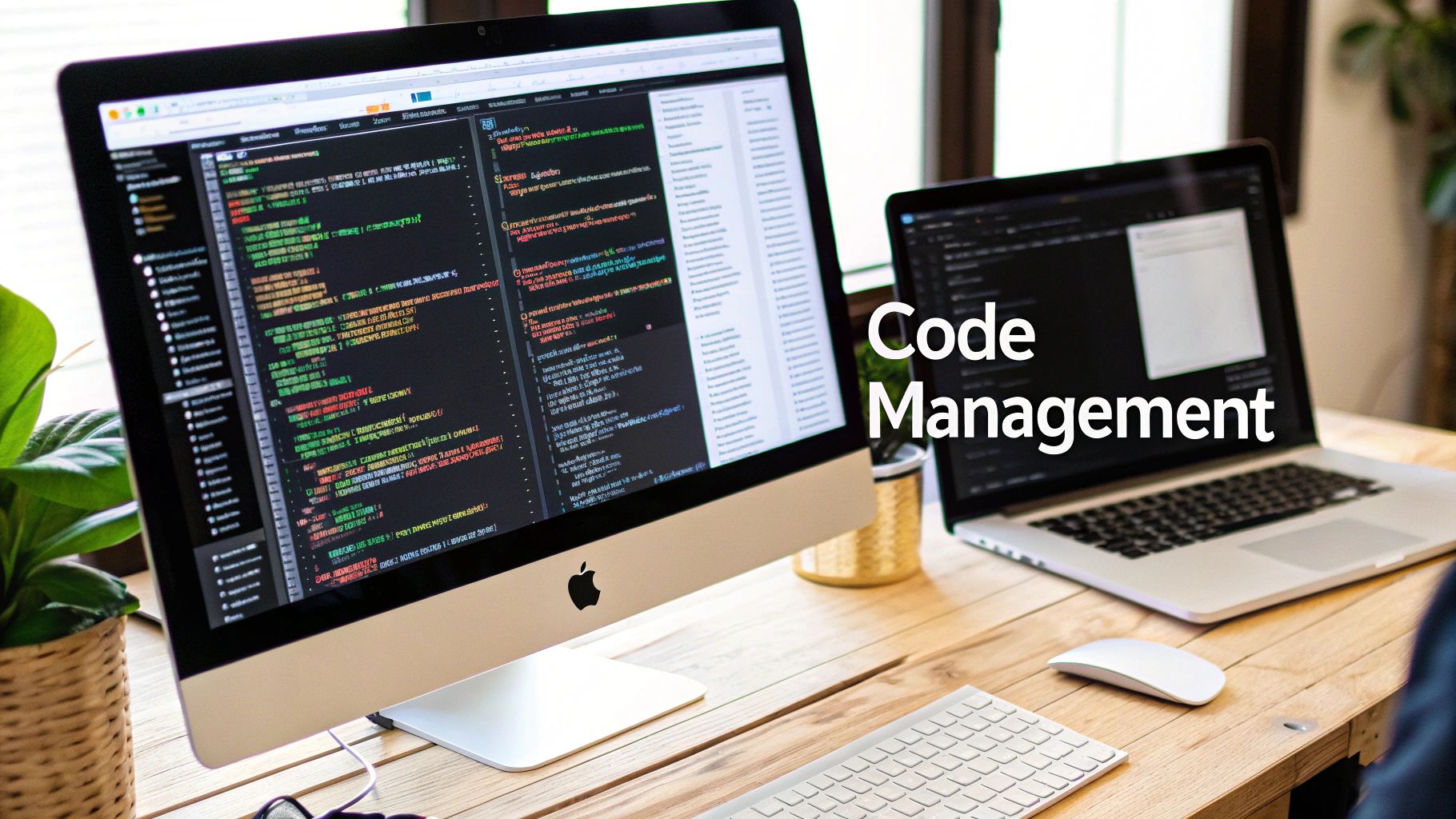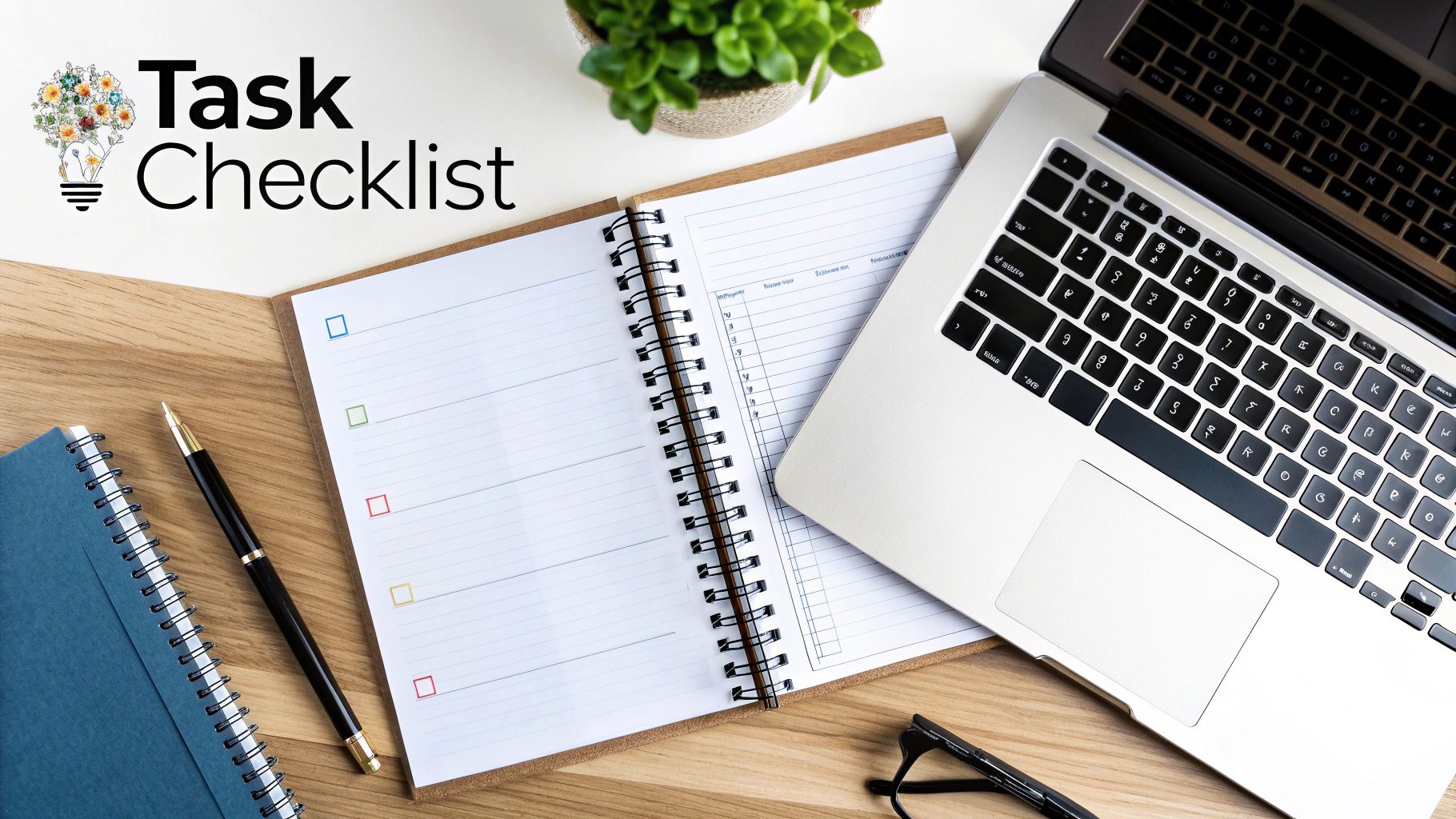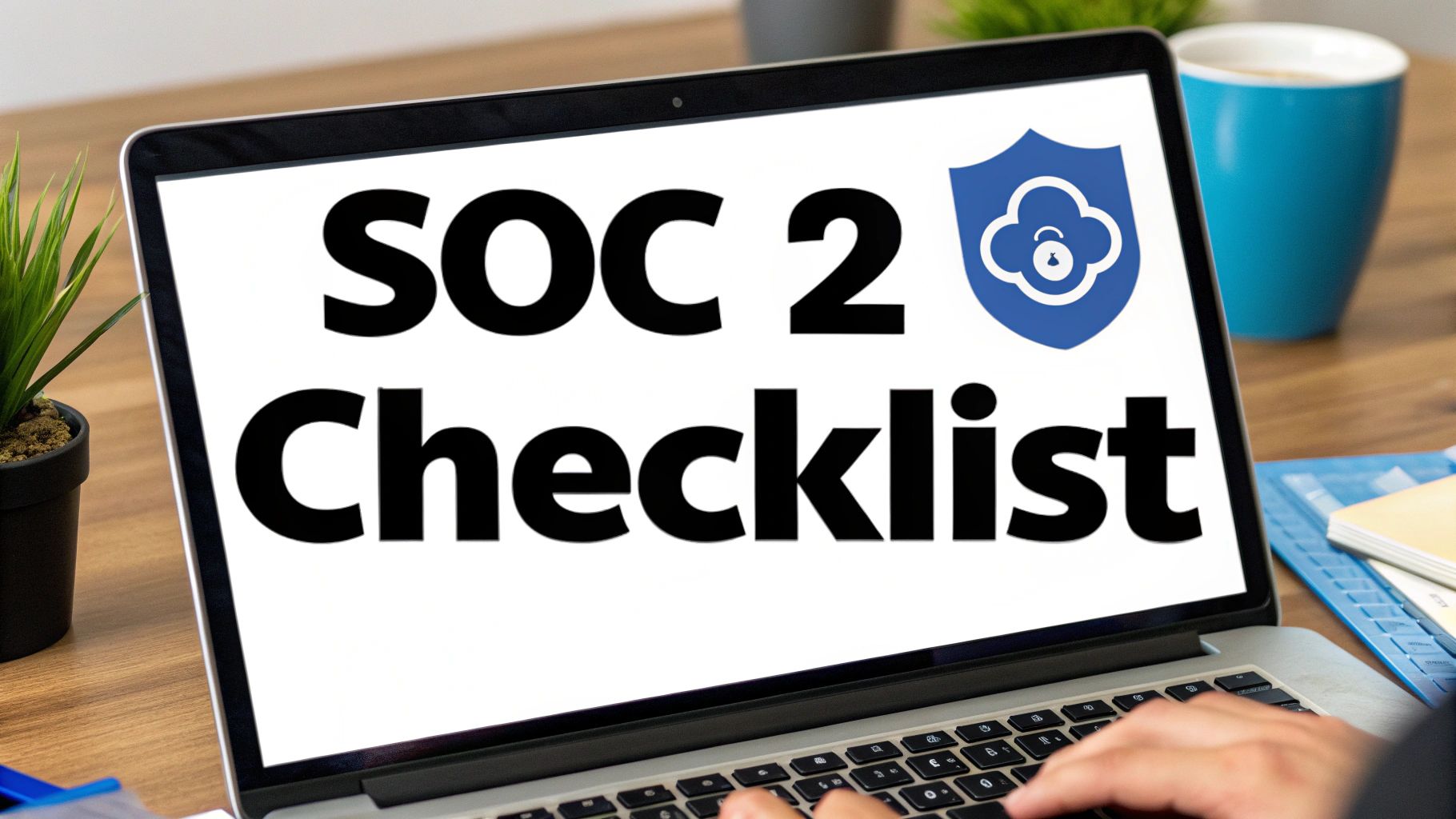The Essential SOC 2 Checklist for GitHub: Your Step-by-Step Implementation Guide
Understanding GitHub's SOC 2 Framework: Beyond the Basics

Getting and keeping SOC 2 compliance on GitHub isn't just about checking boxes. It requires making security a core part of how you develop and deploy code. You need to build security practices directly into your daily workflow, not treat them as an afterthought. But what does good security integration actually look like in practice?
Integrating Security into Your Development Workflow
Many teams still handle security as a separate function, but effective SOC 2 compliance on GitHub means weaving security into every development stage. Security becomes everyone's job, not just the security team's responsibility. From code reviews to testing and deployment, security checks need to be automatic and consistent. Tools like Pull Checklist can help by running security scans automatically during pull requests.
GitHub itself maintains strong SOC 2 Type 2 compliance for its Enterprise Cloud platform. The company provides detailed compliance reports covering 12 months of security, availability and confidentiality controls. Enterprise customers can access these reports directly in their organization settings. Learn more about SOC 2 compliant platforms. This transparency lets users verify GitHub follows the AICPA's control standards.
Leveraging GitHub's Compliance Features
GitHub includes several key features to help teams maintain SOC 2 compliance: granular access controls, detailed audit logging, and security vulnerability scanning. While having these tools is important, knowing how to set them up and use them effectively makes the real difference in staying compliant.
Turning Compliance into a Competitive Advantage
SOC 2 compliance does more than just satisfy requirements - it can set your organization apart. By showing your commitment to security and data protection, you build deeper trust with clients. This leads to stronger relationships and new business opportunities. Strong security also reduces risks from data breaches and other incidents that could hurt your reputation and bottom line. The real value of GitHub SOC 2 compliance comes from creating a more secure and reliable organization.
Conducting Your Gap Analysis: Finding What Actually Matters

A well-executed gap analysis helps you find real security weaknesses - not just theoretical ones. By comparing your current security setup to SOC 2 requirements, you'll understand exactly where you need to improve.
Evaluating Your Current Security Controls
First, take a close look at your existing security setup. This means checking your access controls, how you encrypt data, your incident response plans, and other key security measures. Think of it like doing an inventory check - you need to know what tools you already have before figuring out what's missing.
Understanding the SOC 2 Requirements
SOC 2 is built on five core principles: security, availability, processing integrity, confidentiality, and privacy. Each principle comes with specific requirements your organization must meet. Getting familiar with these standards helps you measure how your current controls match up.
Gap analysis is a key step in getting SOC 2 certified. For platforms like GitHub, this means making sure services like GitHub Actions meet all the necessary security controls. Testing systems, finding misconfigurations, and managing vulnerabilities are essential parts of this process. Learn more about SOC 2 compliance.
Identifying and Prioritizing Gaps
After understanding what SOC 2 requires, you can spot where your security falls short. Not all gaps pose the same level of risk - some need immediate attention while others can wait. Focus first on fixing the most serious security gaps. Tools can help automate security checks in your GitHub workflow, making it easier to fix issues quickly.
Creating an Actionable Remediation Plan
Finding problems is just the start - you need clear solutions. Build a practical fix-it plan that includes:
- Specific timelines
- Who's responsible for what
- Required resources
A solid plan helps track progress and shows auditors you're serious about security. By tackling the most important issues first and following concrete steps, you'll steadily work toward SOC 2 compliance while strengthening your security.
Making Documentation Work for You, Not Against You
Documentation doesn't have to be a painful part of compliance. Smart organizations are turning their documentation into a key asset that shows their dedication to security while making processes run more smoothly. The key is taking a smart, practical approach using the right tools.
Organizing Compliance Materials Effectively
A well-structured soc 2 checklist github repository can make documentation much easier to manage. Having all your compliance materials in one central location eliminates scattered files and outdated versions. GitHub makes it simple for team members to collaborate on and review documents together.
Try organizing your repository folders by SOC 2 principles:
- Security
- Availability
- Processing Integrity
- Confidentiality
- Privacy
This structure helps everyone quickly find what they need.
Establishing Efficient Workflows with GitHub
GitHub provides several features that make documentation workflows run smoothly:
- Version control tracks all changes and maintains audit history
- Branching lets multiple people work simultaneously
- Pull requests enable collaborative review and approval
- Pull Checklist tool automates checks and tasks
These tools help ensure consistent quality no matter who is working on the documentation.
Maintaining Clear Audit Trails for Compliance
Solid audit trails are essential for SOC 2 compliance. GitHub's built-in logging automatically records who made what changes and when, providing excellent evidence for audits. The platform also makes it easy to access key compliance reports - enterprise and organization owners can find them under Settings > Compliance. Learn more about accessing reports in the GitHub documentation.
Using these approaches transforms your soc 2 checklist github from an obligation into a tool that improves security and simplifies compliance. The result is not just satisfied auditors but a stronger security-minded culture throughout your organization.
Implementing Security Controls That Actually Work

Effective security requires more than just checking boxes. To properly protect your systems and data, security needs to be woven into your development processes and supported by the right GitHub tools. This approach helps you meet SOC 2 requirements while building real security protections.
Access Management and Authentication Protocols
Think of access management like securing your home - you need to control who has keys and what areas they can access. Within GitHub, this means using:
- Repository permissions with specific access levels
- Branch protection rules to prevent unauthorized changes
- Two-factor authentication (2FA) for all users
- Regular access reviews to remove outdated permissions
These controls ensure only the right people can access sensitive code and data.
Leveraging GitHub's Security Features for SOC 2
GitHub provides several powerful security tools that help with SOC 2 compliance. The platform's security vulnerability scanning automatically finds code weaknesses before they become problems. This shows auditors you're serious about security. Having a dedicated SOC 2 checklist repository helps organize your compliance documentation and track progress.
Building a Robust Monitoring System with Pull Checklist
Keeping watch over your systems is critical for strong security. You need to quickly spot unusual activity and potential breaches. Pull Checklist from the GitHub Marketplace makes this easier by automating key security checks in your development process. By requiring specific reviews for each pull request, it helps catch issues early and maintains consistent security standards.
Streamlining Documentation and Audits with a Centralized Checklist
Good documentation proves your security controls work and helps during audits. Keep all your policies, procedures and compliance evidence in a central SOC 2 checklist repository. This organized approach makes audits smoother since everything is easy to find. Pull Checklist also helps by automatically tracking and documenting security reviews. This frees up your team to focus on building secure software rather than managing paperwork.
Building a Culture of Continuous Compliance
Security requires ongoing attention and effort from everyone in your organization. To maintain SOC 2 compliance, your team needs to weave security practices into their daily work. Making security a priority alongside development speed creates a stronger, more secure GitHub environment.
Establishing Effective Monitoring Systems
Think of monitoring like having security cameras watching your systems at all times. Good monitoring means tracking system activity, spotting unusual events quickly, and taking action when needed. Set up alerts to flag suspicious activity and regularly check audit logs to catch issues early. Tools like Pull Checklist can automatically run security checks during pull requests to strengthen your monitoring.
Responding to Security Incidents: A Proactive Approach
Security incidents can happen despite careful precautions. Your team needs a clear incident response plan to minimize damage and recover quickly. Document specific steps for identifying, containing, and eliminating threats. Include communication guidelines to keep everyone informed. Run practice drills so your team knows exactly what to do when problems arise.
Keeping Your Team Engaged in Maintaining SOC 2 Compliance
Everyone plays a part in maintaining security. Regular training sessions help your team stay current on security best practices and new types of threats. Create an environment where people feel comfortable reporting security concerns. Consider adding fun elements to security training or offering incentives for finding vulnerabilities to build shared ownership.
Integrating Security Seamlessly into Your Development Workflow
Security works best when it's built into development from the start. Add security checks at each stage - from code reviews through deployment - to catch potential issues early. Store all your compliance materials in a soc 2 checklist github repository to help teams follow security protocols. Using Pull Checklist automates these checks during pull requests, ensuring consistent security practices even when teams work in unfamiliar code. When security becomes routine, it strengthens your entire system without slowing down development.
Preparing for Audits: Your Practical Success Guide

Turn your next audit from a source of stress into an opportunity to highlight your security program's strength. With proper planning and organization, you can build confidence in your controls and processes. Here's how to stay ready for audits throughout the year.
Maintaining Detailed Audit Trails
Think of your audit trail as a security camera - it captures a clear record of all important actions. Within GitHub, use the built-in logging features to automatically document changes and user activity. A well-structured soc 2 checklist github repository helps organize this information in one central place, making it easy for auditors to review.
Organizing Evidence Effectively
Good organization prevents the "needle in a haystack" problem during audits. Structure your evidence according to SOC 2's main principles. Create dedicated folders in your soc 2 checklist github repository for each area: security, availability, processing, confidentiality, and privacy. This makes finding specific documentation quick and simple.
Presenting Your Compliance Story with Confidence
An audit is your chance to show how well you understand and manage security. Be ready to walk auditors through how your controls meet SOC 2 requirements. Practice explaining your processes ahead of time. When you can discuss your program confidently, it shows you truly know your stuff.
Staying Audit-Ready Year-Round
Regular upkeep beats last-minute scrambling every time. Keep your soc 2 checklist github repository current with frequent reviews and updates. Schedule internal checks to spot and fix any gaps before external auditors arrive. This ongoing attention helps build security awareness across your team.
Using Audit Findings to Strengthen Your Security Program
See audits as chances to improve, not just pass/fail tests. Take audit feedback seriously and use it to make your controls better. When you actively respond to findings, it shows you're serious about security. Tools like Pull Checklist can help automate key processes to maintain your improved controls consistently.
Ready to make audit prep easier? Pull Checklist helps automate security checks and keeps your soc 2 checklist github repository organized. Try it free and see how much simpler compliance can be! Get started with Pull Checklist.
